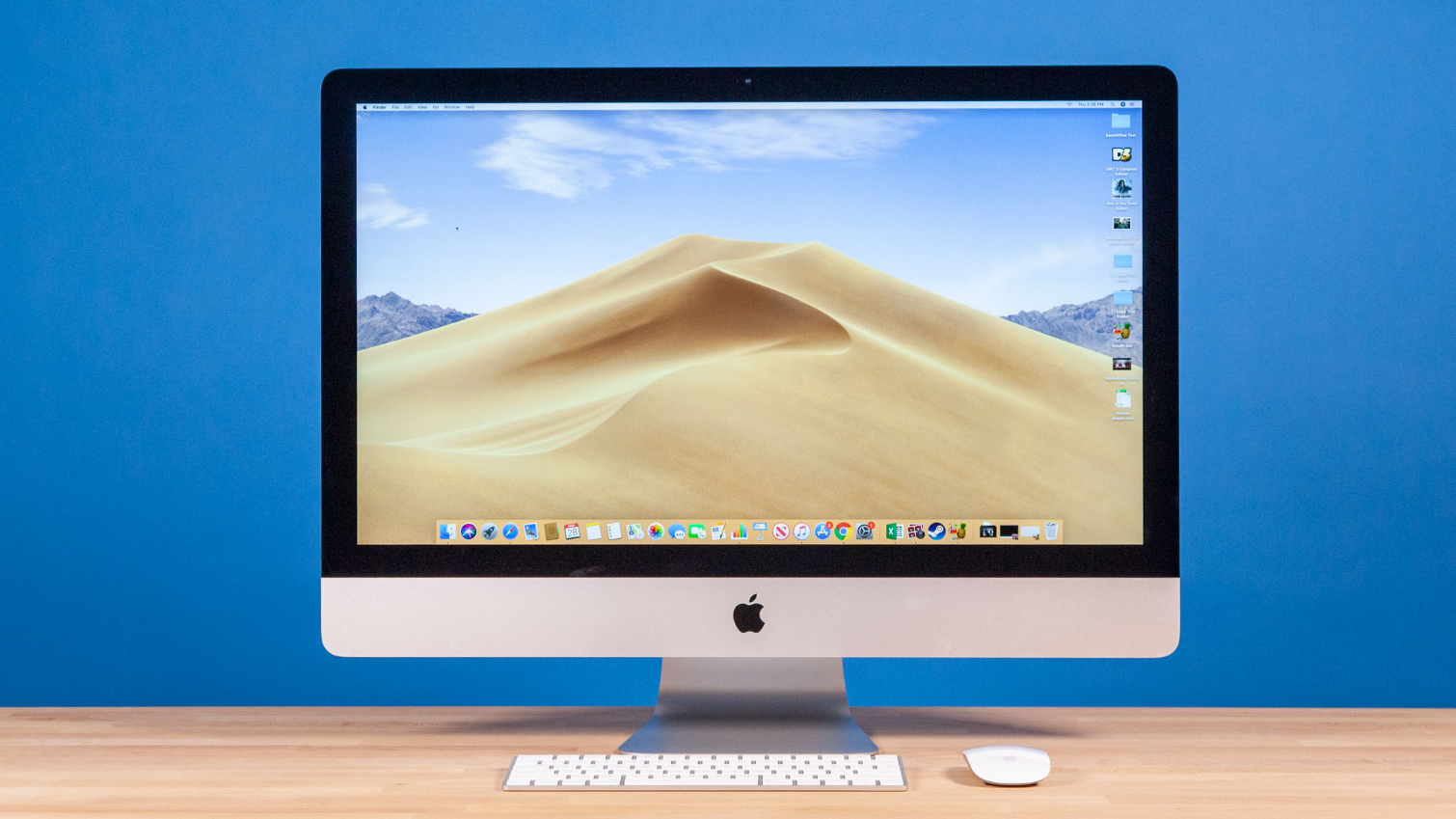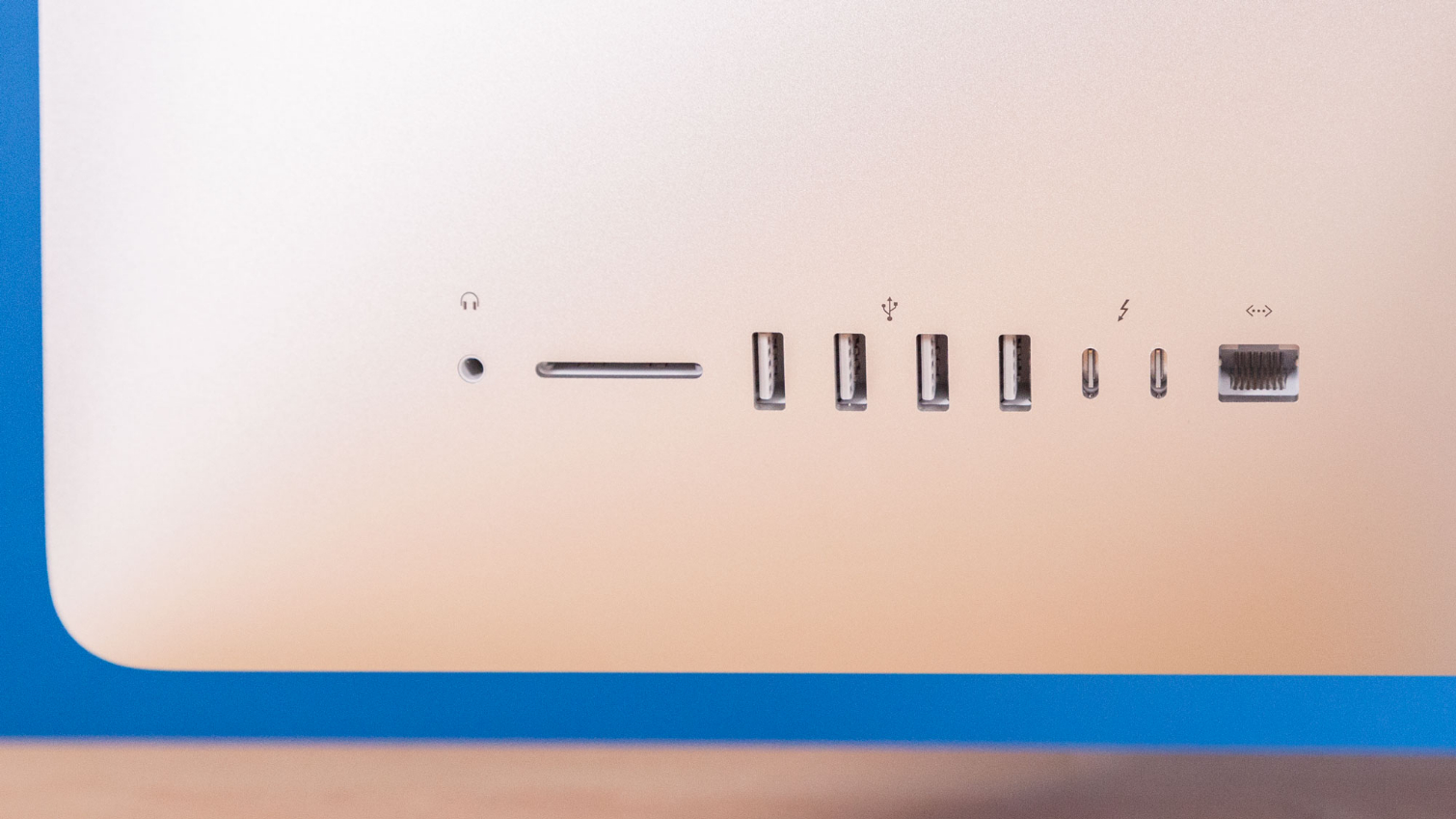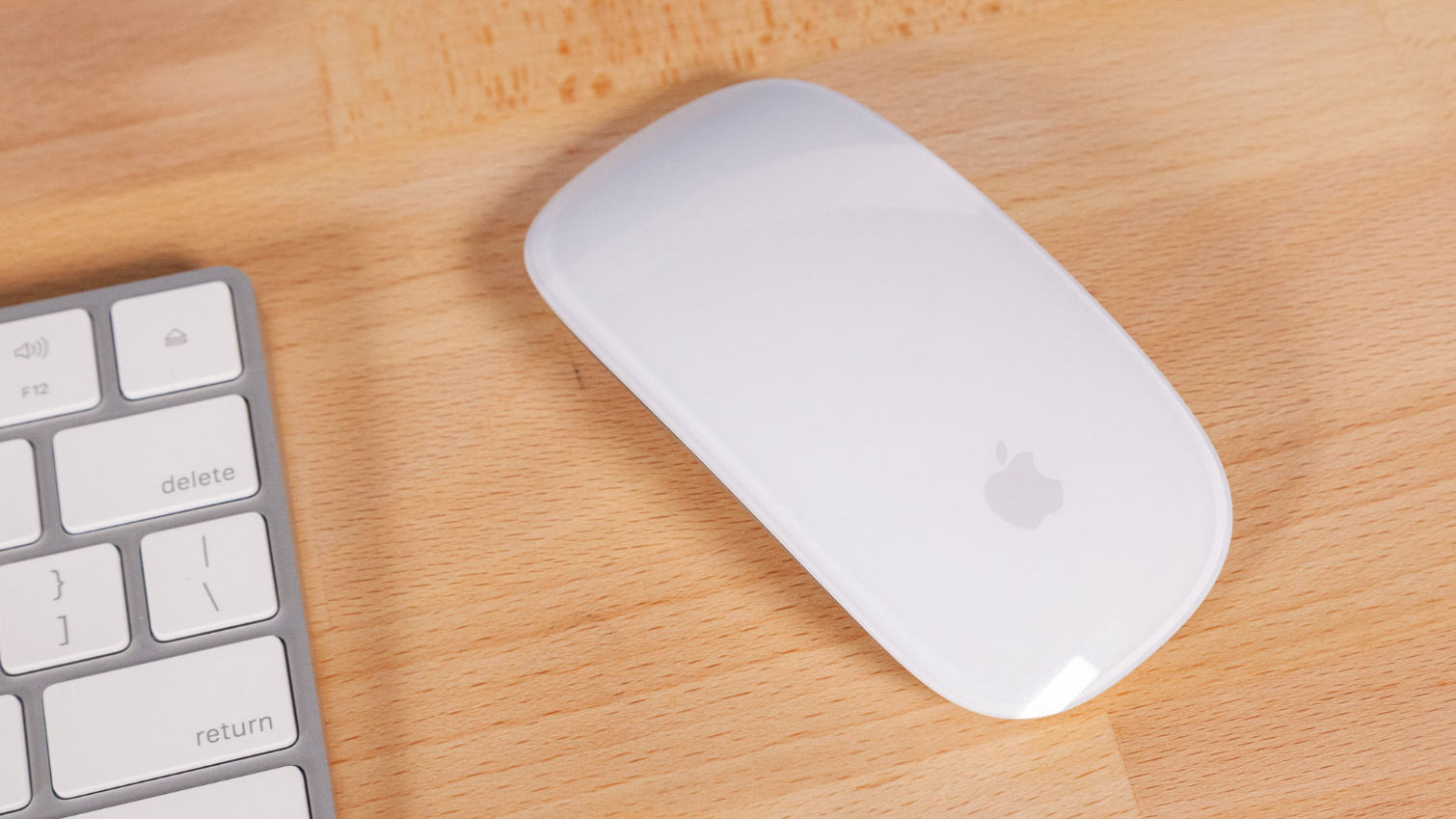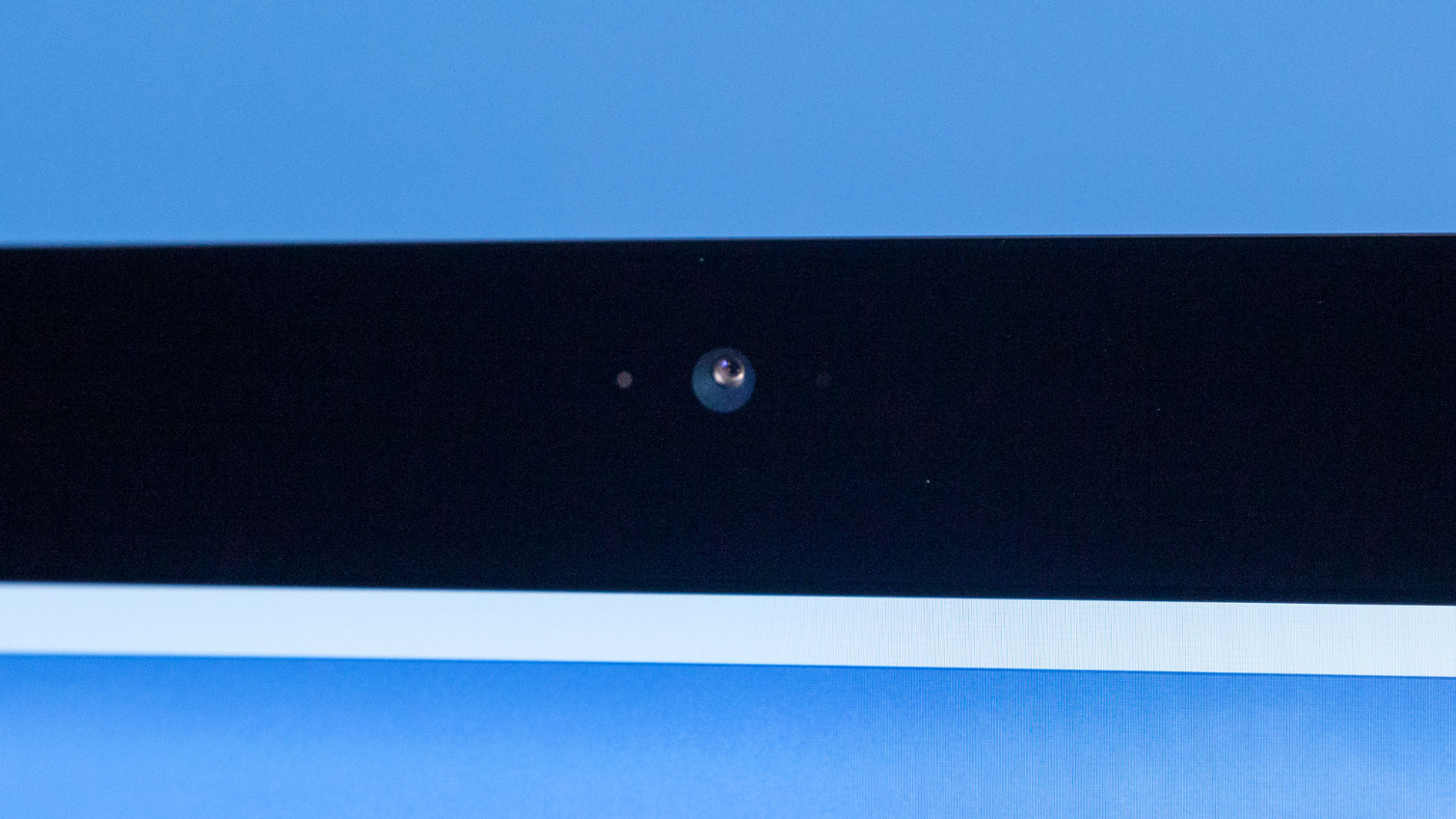Tom's Guide Verdict
The new iMac is an excellent all-in-one for creative professionals, thanks to its gorgeous 5K display, breakneck speeds and powerful speakers.
Pros
- +
Gorgeous 5K display
- +
Blistering speed
- +
Improved graphics performance
- +
Sleek (albeit, aging) design
Cons
- -
Thick bezels
- -
No touch-screen option
- -
No height adjustment
- -
Ports are rear-mounted
Why you can trust Tom's Guide
Apple's popular 27-inch iMac (starting at $1,799, reviewed at $3,449) has always been a top pick for a wide range of power users, from enterprise executives to online influencers. This year, Apple quietly refreshed both the 21.5-inch and 27-inch iMac models with upgraded processors and graphics cards. Now boasting 6-core and 8-core CPUs, the 27-inch version, in particular, received a major performance boost.
Combine that power with a gorgeous 5K display and powerful speakers, and Apple's reliable formula has produced one of the company's best all-in-one PCs yet. However, those hoping for a radical redesign might be disappointed by this year's excellent, yet conservative iteration.
Apple 27-inch iMac Price and Configurations
The base 27-inch iMac starts at $1,799 and comes with an 8th Gen 3.0-GHz Intel Core i5 CPU, 8GB of RAM, a 1TB Fusion Drive and an AMD Radeon 570X GPU with 4GB of DDR5 memory. On the top end is a $5,249 configuration that packs a 9th Gen 3.6-GHz Intel Core i9 CPU, 64GB of RAM and Radeon Pro Vega 48 with 8GB of VRAM. There are a number of other CPU, RAM, SSD and GPU options, so you can customize the iMac to your desired performance and price.
Our $3,449 review unit came equipped with a 9th Gen 3.6Ghz 8-core Intel Core i9 CPU, 16GB of RAM, a 512GB SSD and Radeon Pro Vega 48 graphics with 8GB of HBM2 memory.
Design
Command+C, Command+V. Yes, another few years have passed and Apple still hasn't made any major changes to the iMac's design since slimming it down in 2012. And yet, the new iMac remains an attractive all-in-one.
Get instant access to breaking news, the hottest reviews, great deals and helpful tips.

Sporting Apple's signature silver aluminum finish, the all-in-one has a simple yet sophisticated design, although I was hoping the iMac would adopt the iMac Pro's snazzy space-gray color variant. The iMac's 27-inch display is surrounded by thick black bezels that look massive when compared with Apple's newer products, like the iPhone XS and the iPad Pro. We'll keep crossing our fingers for a redesign that does away with the bezels so there'll be nothing to distract us from the iMac's mesmerizing 5K display.
Underneath the display is a silver metal chin with a centered black Apple logo, while the back has subtle convex curves that give it an elegant pillowy shape. Another shiny black Apple logo adorns the rear, above a vent and a small access panel. Just below that is a power connector that sits in line with a row of ports on the back-right corner.
Apple still hasn't made any major changes to the iMac's design since slimming it down in 2012.
A slim, intricately curved stand keeps the 5-millimeter frame hovering a few inches off the desk. While the stand feels sturdy and looks great, it isn't very practical because you still can't adjust the display height. There is, at least, a circular cutout for feeding wires through, and the hinge allows you to tilt the display up and down.
MORE: Best Apple Laptops
Measuring 25.6 x 20.3 x 8 inches and weighing 20.8 pounds, the iMac isn't any larger than its 27-inch competitors, like the Microsoft Surface Studio 2 (25.1 x 17.3 x 8.7 inches, 21 pounds) and the Dell XPS 27 (24.6 x 17 x 3.16 inches, 38.2 pounds).
Ports
The 2019 iMac has a generous selection of ports but you'll need to turn the all-in-one around or reach behind its wide frame to get to them. Those who have a more permanent setup won't have to endure the frustration I felt repositioning the iMac every time I connected an external hard drive. The headphone jack is on the rear instead of the side, making it particularly irredeemable. Then again, if Apple had its way we'd all be wearing wireless AirPods.

Nevertheless, the iMac has just about every connection you could ask for, including four USB 3.0 ports, an SDXC card reader, a Gigabit Ethernet port, a headphone jack and a Kensington lock slot. There are also two Thunderbolt 3 ports for connecting superfast data transfer, video output to multiple 4K monitors and charging peripherals. Regarding connectivity, the iMac supports 802.11ac Wi-Fi and Bluetooth 4.2, not the newer Bluetooth 5 standard.
Display
The 2019 iMac has the same 27-inch, 5K (5120 x 2880-pixels) Retina panel as the 2017 model, which means you can expect a crisp, colorful and bright picture.

When I watched a trailer for the upcoming film Once Upon a Time in Hollywood, the 5K display captured so much detail that I could make out small beads of sweat pooling on Leonardo DiCaprio's tanned forehead. I also noticed subtle red lines under Leo's distressed eyes that I might not have noticed on another display. Vivid blue and red tones burst off the iMac's screen during a scene where Brad Pitt drives down a neon-lit street.
Text looks crisp on this high-resolution panel, and I had no problems using macOS' split screen to write this review on one half of the 27-inch panel while watching a video on the other. Photo and video editors, in particular, will appreciate the extra pixels when they're zooming in on high-resolution content.
When I watched a trailer for the upcoming film Once Upon a Time in Hollywood, the 5K display captured so much detail that I could make out small beads of sweat pooling on Leonardo DiCaprio's tanned forehead.
There is one major piece missing from the iMac's display: touch support. Windows desktops and PCs have embraced touch since the release of Windows 8, while Apple has turned a blind eye to the feature. Windows all-in-ones with stylus support, like the Surface Studio 2, give creative professionals greater precision over their work that the iMac' non-touch panel simply doesn't offer.
The iMac's 27-inch display peaked at 425 nits of average brightness. That is a strong result, but lower than what the iMac Pro (458 nits), Surface Studio 2 (456 nits) and the 2017 iMac (463 nits) registered. The Dell XPS 27's display doesn't get as bright as the competition, maxing out at 344 nits.
According to our colorimeter, the vivid 5K panel covers 129 percent of the sRGB color gamut. Again, while that is an above-average result, the displays on the Surface Studio 2 (167 percent), iMac Pro (167 percent) and XPS 27 (187 percent) reproduced more colors.
MORE: Out Of Juice: Apple Pulls the Plug on AirPower
The iMac has one of the most color-accurate displays we've ever tested. The panel has a Delta-E rating of .09 (zero is a perfect score), which means that it's more accurate than the displays on the Surface Studio 2 (1.3) and XPS 27 (0.11). The iMac Pro, however, topped the iMac once again with a Delta-E score of 0.06.
Mouse and Keyboard
Apple still ships the iMac with the Magic Keyboard and Magic Mouse 2 along with a Lighting-to-USB cable to charge them. Both wireless accessories instantly connected to the iMac the moment I turned them on and I didn't experience any connection issues during my testing. Better yet, the mouse accurately tracked my movements, and there was no delay while typing.

The Magic Keyboard is very portable and has that clean, luxurious design Apple products are known for. However, I'm not sold on the typing experience. With just 0.9 millimeters of travel, the keys are quite shallow and they made a rattling sound when I pressed them. An actuation force of 70 grams saves the day, giving the keys a much-needed tactile click.
I typed at a rate of 106 words per minute with an accuracy of 88 percent on the 10FastFingers.com typing test. That is slower and less accurate than my typical 109 wpm at 95 percent accuracy.

The Magic Mouse 2 is just as visually stunning as the keyboard. The gently curved aluminum base with glass coating makes the mouse look like a work of art. However, it's not contoured to form to the shape of your hand like other, more ergonomic, mice.
A more pressing criticism, however, is that the Lightning charging port is on the bottom of the mouse, so you can't use it while it's charging. That feels like a major oversight and one that Apple should have addressed by now. Still, "magic" touch gestures for swiping between web pages and scrolling worked as advertised.
Audio
The rear-firing speakers on the iMac easily filled our medium-size lab with warm, detailed sound. When I listened to Sampha's (No One Knows Me) Like the Piano, the soul singer's voice was clear and full-bodied. There was even a surprising meatiness to the drum beats in Glass Animals' Season 2 Episode 3, which I comfortably listened to on the opposite side of the room with the volume at only 75 percent.
Performance
As new 6-core and 8-core processors are one of two major upgrades to this year's iMac, there is a lot riding on them. Fortunately, our review unit — configured with a 9th Gen Intel Core i9 CPU and 16GB of RAM — didn't disappoint. The refreshed CPUs blazed through our real-world and benchmark testing and nearly closed the performance gap with the iMac Pro.
My real-world testing involved loading 20 Google Chrome tabs, four of which played full HD YouTube videos while another pair streamed video games on Twitch. The iMac didn't even break a sweat, so I fired up 20 more tabs, half a dozen of which played 1080p video. Still, the iMac didn't flinch and even had enough juice remaining to download a 1080p trailer of the upcoming film John Wick: Chapter 3 - Parabellum in just 25 seconds.
The iMac's refreshed CPUs blazed through our real-world and benchmark testing and nearly closed the performance gap with the iMac Pro.
The iMac embarrassed the competition in our benchmarks, scoring a mind-blowing 33,035 on the Geekbench 4 overall performance test. That crushes the scores posted by the Surface Studio 2 (14,971, Intel Core i7-7820HQ CPU) and the XPS 27 7760 (15,749, Intel Core i7-7700 CPU) and nearly the class-leading score achieved by its professional-grade sibling, the iMac Pro (Intel Xeon W-2150B, 36,705).
Our iMac's 512GB SSD offered practically inconceivable data-transfer speeds, hitting write speeds of 1909 megabytes per second and read speeds of 2,545 MBps on the BlackMagic Disk Speed synthetic benchmark. The only all-in-one in the same ballpark is the iMac Pro, which actually topped the iMac with a transfer rate of 2,544 MBps. The Surface Studio 2 (815 MBps) and the XPS 27 (1,208 MBps) lagged far behind despite their respectable results.
MORE: Apple TV Plus Is Coming This Fall: Everything You Need to Know
The iMac continued its hot streak on our Excel Macro Test, matching 65,000 names with their corresponding addresses in just 29 seconds. That's several times faster than the results from the Surface Studio 2 (1:01) and XPS 27 (3:00).
Graphics and Gaming
The other major change to the new iMac, apart from its beefed-up CPUs, are its upgraded graphics options. With the Pro Vega 48 GPU, Apple is bringing professional-grade graphics performance to a consumer-focused product. Thanks to the upgrades, content producers who use demanding programs like Adobe Photoshop and Autodesk Maya won't have to wait as long for RAW images to import or 3D effects to render.
It's a shame there aren't more games available on Mac because the latest iMac has enough steam to run even the latest titles at very high settings. Apart from the beefy new processors, the other major change to the new iMac is its upgraded GPU options. Apple now offers the iMac with AMD Radeon Vega graphics, which supposedly offers 80 percent faster graphics performance compared with the GPUs in the 2017 model.
The Radeon Pro Vega 48 GPU with 8GB of HBM2 inside of our iMac proved as much in our testing, playing Rise of the Tomb Raider (1080p on Very High settings) at a smooth 44 frames per second. That doesn't quite match the 51 fps achieved by the Surface Studio 2 (Nvidia GTX 1070 GPU) but it's well above our 30-fps playability threshold.
Webcam
The iMac's FaceTime HD camera could use an upgrade. The 720p webcam produces a decent image but other premium all-in-ones, like Apple's own iMac Pro, have 1080p cameras that produce shaper, brighter images. The selfie I shot in our dimly lit office was blurry on this large, 5K display, and my co-worker described my face as looking sickly.

Still, the camera is much better than anything you'll find on a laptop. It was able to capture strands of hair in my beard and the rosy tone in my face. Those details sharpened and my face brightened when I connected my Logitech C920 external webcam.
Software and Warranty
The iMac runs macOS Mojave, the latest version of Apple's desktop operating system. You'll find all the typical Apple apps pre-installed on the iMac, including iMovie for video editing, GarageBand for music creation, and, of course, Apple's virtual assistant Siri.
While Mojave isn't a major departure from High Sierra, it does add some key new features. The highlight is Dark Mode, which paints macOS' traditionally bright white interfaces in darker tones. Aside from the cool factor, the dark mode has a number of reported benefits, from reducing eye fatigue to improving sleep.
MORE: Apple Card Doesn't Need to Be Revolutionary to Be a Hit
Another useful feature, Continuity Camera, lets you scan documents or take pictures with your mobile device — an iPhone, iPad or iPad Touch — and instantly send them into the Finger, Mail or Messages apps.
Apple ships the iMac with a one-year warranty and 90 days of complementary tech support. You can purchase AppleCare+ for $169 to extend coverage for three years and add two incidents of accidental-damage coverage.
Bottom Line
The new 27-inch iMac takes one of our favorite all-in-ones and gives it a significant speed boost. The 9th Gen Intel Core i9 CPU and Radeon Vega 48 GPU in our review unit crushed every benchmark we threw at them. There are plenty of other reasons to buy the new iMac over its Windows rivals; Apple's newest all-in-one has a gorgeous 4K display, elegant (if somewhat dated) design and powerful audio.
However, if you own the 2017 iMac and are happy with its performance, then there's little reason to upgrade to the new version. Furthermore, if you want the very best performance, then you're still better off buying the iMac Pro, a brawnier all-in-one targeted more toward professionals than everyday consumers. Also, if you're a content creator who prefers to use a stylus over a mouse, then we recommend an all-in-one that supports touch, like the excellent Surface Studio 2.
Still, the performance improvements to the new iMac are a compelling enough reason to upgrade from an older model, unless you have $4,999 to spare on the iMac Pro.
Got your heart set on the new iMac, but struggling with the price? Make sure you check out our Apple discount codes for all the latest ways to save.
Credit: Tom's Guide
Phillip Tracy is the assistant managing editor at Laptop Mag where he reviews laptops, phones and other gadgets while covering the latest industry news. Previously, he was a Senior Writer at Tom's Guide and has also been a tech reporter at the Daily Dot. There, he wrote reviews for a range of gadgets and covered everything from social media trends to cybersecurity. Prior to that, he wrote for RCR Wireless News covering 5G and IoT. When he's not tinkering with devices, you can find Phillip playing video games, reading, traveling or watching soccer.

